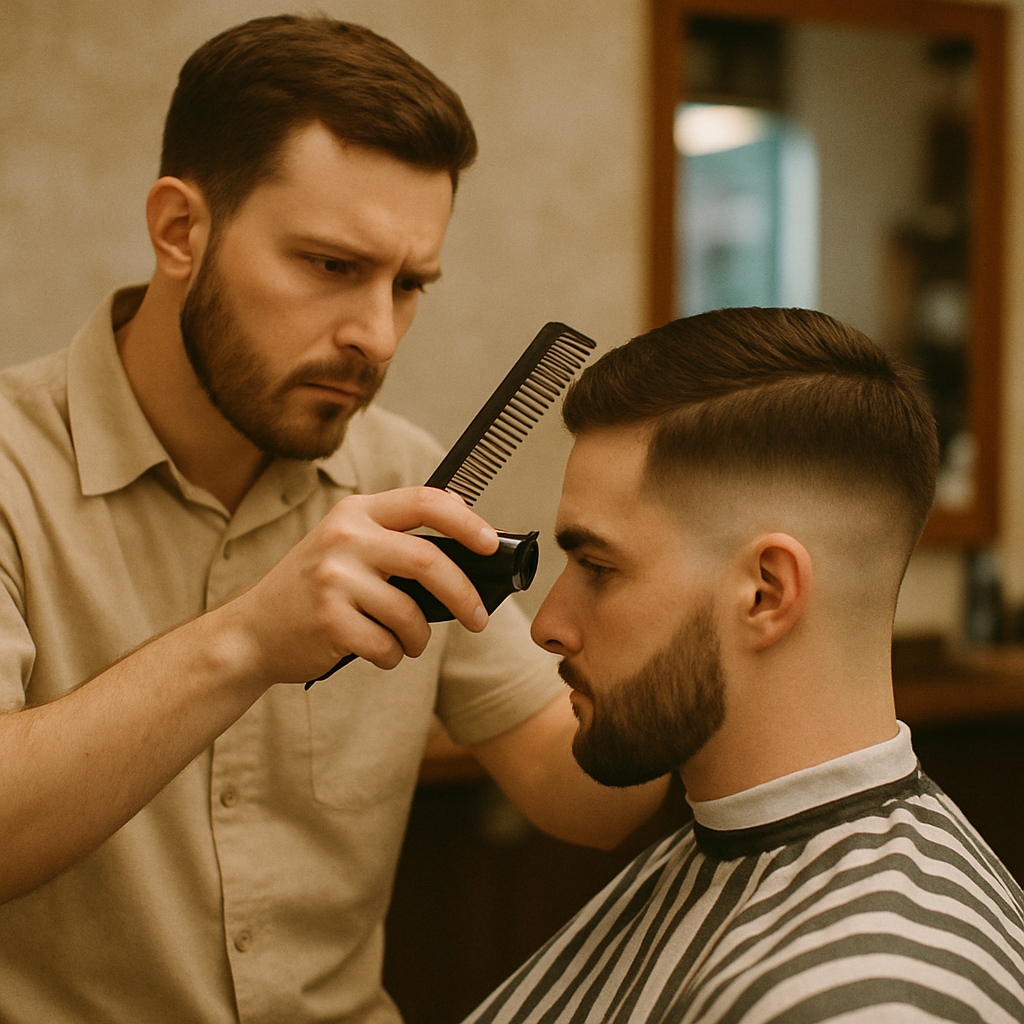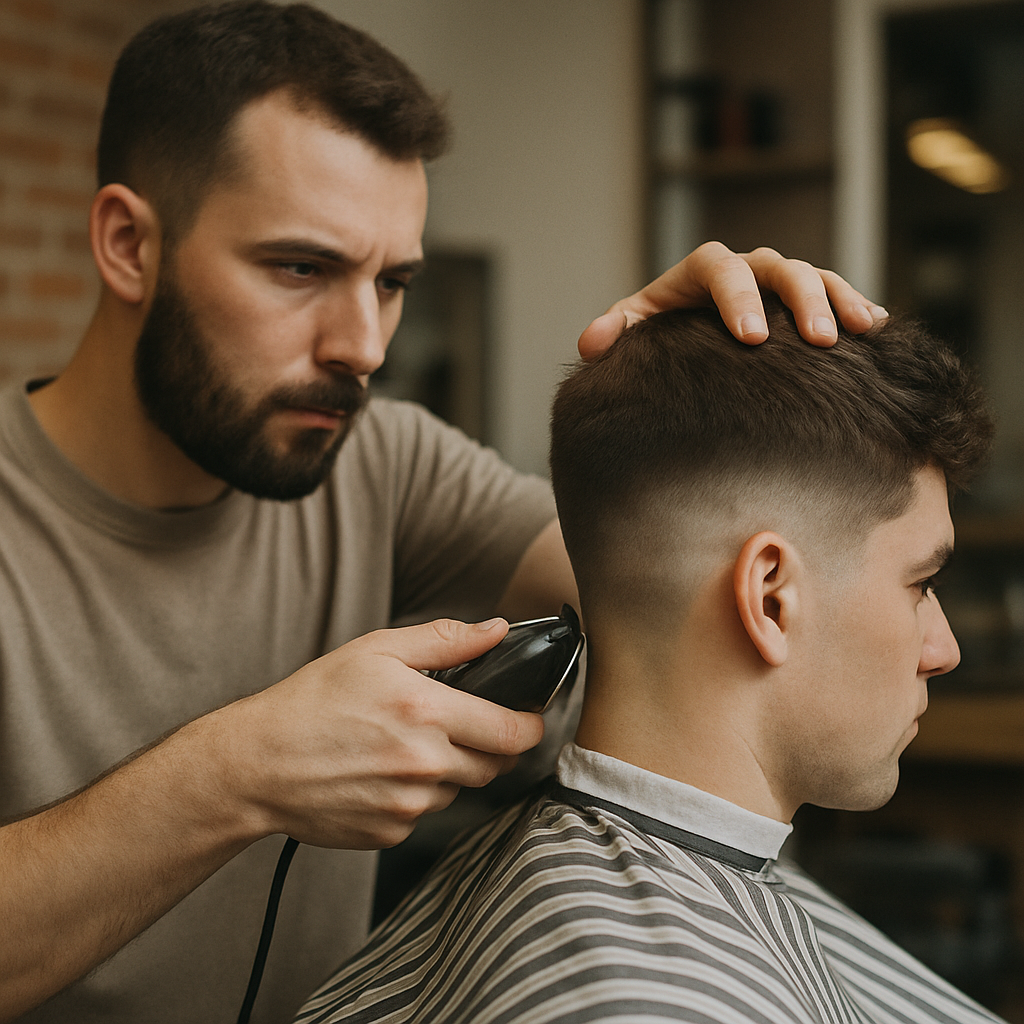Fades vs Tapers What s the Difference and Which One s Right for You
Choosing the right haircut can be a game-changer for your style. Fades and tapers are two popular options. Both offer a clean, sharp look. But how do you decide which is best for you?
Fades involve a dramatic transition from longer to shorter hair. They often go down to the skin. This style is bold and modern, perfect for those who want to stand out.
Tapers, on the other hand, offer a more subtle transition. They maintain some length at the bottom. This makes them versatile and suitable for professional settings.
Understanding the differences can help you make an informed choice. Whether you prefer a fade or a taper, both styles can enhance your look. Let's explore these options further.
What Is a Fade Haircut?
A fade haircut is sleek and stylish, known for its distinctive look. It features a seamless blend from longer hair on top to shorter hair below. This transition often includes a sharp contrast, reaching skin level.
Fades can highlight facial features, making them popular among those seeking a modern edge. The style often involves precise clipper work. Skilled barbers are essential for achieving the perfect fade.
There are several types of fades to consider. Common variations include low, mid, and high fades. Each type defines where the transition begins, influencing the final appearance.
- Low fade: Starts just above the ears.
- Mid fade: Begins between the temple and ear level.
- High fade: Initiates at or above the temples.
Fades require regular touch-ups to maintain their crisp look. They are versatile enough to pair with various top styles like pompadours or quiffs. This adaptability makes fades a top choice for athletes and celebrities alike. The clean lines can transform your look while offering confidence and style.
What Is a Taper Haircut?
The taper haircut is a classic choice, known for its subtlety and versatility. It features a gradual reduction in hair length from top to bottom, creating a softer transition than a fade.
Tapers are ideal for those who want a polished look. Unlike fades, tapers maintain more hair at the bottom. This characteristic makes them suitable for both professional and casual settings.
A taper provides a timeless appearance. It's a go-to option for anyone seeking a conservative style. This cut is perfect for maintaining a balanced look, especially for those new to shorter hairstyles.
There are various taper styles to explore. Each option caters to different preferences and lifestyles:
- Classic taper: Traditional, with gentle transition.
- Low taper: Starts just above the ear, very subtle.
- High taper: Provides more contrast, begins higher up.
With their adaptable nature, tapers pair well with longer top styles like crew cuts or side parts. They offer a foundation for styling creativity, ensuring you can achieve a look that fits any occasion. Their low-maintenance nature appeals to those who prefer minimal grooming routines.
Fades vs Tapers: Key Differences
Fades and tapers are both popular short haircuts with unique features. Understanding their key differences can help you make an informed decision.
Fades involve a more dramatic reduction in hair length compared to tapers. They typically extend down to the skin, creating a sharp contrast between hair lengths. In contrast, tapers involve a subtle transition, maintaining more hair as it reaches the bottom.
The fade haircut is ideal for those looking for a bolder, more modern style. On the other hand, tapers are better suited for conservative looks. They work well in both formal and casual settings.
Here are some distinguishing characteristics:
- Fade: Bold, edgy, skin-short transition.
- Taper: Subtle, conservative, longer at the base.

Fades often require more frequent touch-ups to maintain their crisp appearance. Tapers demand less upkeep, making them a choice for those seeking a classic style with minimal maintenance. Personal preference and lifestyle should guide your choice. Whether you opt for a fade or a taper, both styles allow room for personalization and creativity.
Types of Fades and Tapers
Types of Fades
Fade haircuts come in various forms, each offering a distinct style. The primary types are low, mid, and high fades.
Low fades start near the ear, providing a subtle yet refined look. They are perfect for adding a bit of flair without being too bold. The fade becomes more apparent closer to the neckline.
Mid fades start higher on the head, around the temple area. This style is popular for its versatility and balance of subtlety and boldness. Mid fades work well for most face shapes and hair types.
High fades are the most striking, with the transition beginning near the top of the head. They emphasize angular features and can add a stylish edge to one's look.
Here are the main fade types:
- Low Fade: Subtle, near the ear
- Mid Fade: Balanced, around the temples
- High Fade: Bold, near the top

When choosing a fade type, consider your personal style and face shape to ensure the best results.
Types of Tapers
Taper haircuts also have variations that cater to different preferences. The most common types include classic taper, low taper, and temple taper.
Classic tapers involve a gradual reduction in hair length, usually down to the hairline. This style is timeless and suits all occasions, offering a polished look.
Low tapers focus on the lower part of the head, starting just above the ear. They provide a neat appearance while maintaining length on top and at the sides.
Temple tapers feature a quick transition around the temples, adding a modern twist to the traditional taper. This style blends seamlessly with other hairstyles, making it versatile.
Popular taper variations include:
- Classic Taper: Timeless, gradual transition
- Low Taper: Neat, focus on lower head
- Temple Taper: Modern, focus on temples

Choosing a taper style depends on your grooming preferences and desired level of maintenance. Each type offers a unique way to personalize your haircut.
Pros and Cons: Fades vs Tapers
Choosing between fades and tapers can be tricky. Both styles have unique advantages that cater to different tastes.
Fades offer a dramatic look. They appeal to those seeking a contemporary style. The bold transition can highlight facial features, making them popular in fashion-forward circles.
However, fades require more frequent maintenance to stay sharp. This can be time-consuming for those preferring low-maintenance haircuts. The contrast in lengths can also make growing out a fade challenging.
Tapers, on the other hand, offer a more subtle and versatile style. They suit both casual and formal occasions seamlessly. Tapers are also easier to maintain, as they don't require frequent touch-ups.
Yet, tapers might not provide the edgy look some desire. They blend more naturally, potentially lacking the striking impact of a fade.
Here's a quick comparison of the pros and cons:
- Fades: Bold, highlights features, requires maintenance
- Tapers: Subtle, versatile, easier upkeep
Choosing the right style depends on personal preferences and lifestyle needs.
How to Choose: Face Shape, Hair Type, and Lifestyle
Picking between a fade or a taper involves considering your face shape. Each style can enhance different features.
A fade might suit angular face shapes. It highlights sharp features like cheekbones and jawlines. This style accentuates facial contours effectively.
Round face shapes often benefit from tapers. Their subtle transitions create balance and harmony, softening facial lines.
Hair type also plays a crucial role. Coarser hair types often favor fades for their pronounced look. Tapers might work better with finer hair, as they maintain more volume and texture.
Lifestyle choices should not be overlooked. Busy individuals might prefer tapers. Their lower upkeep fits well with a packed schedule.
Conversely, if you relish frequent salon visits and touch-ups, a fade can offer a dynamic style change. Fashion-conscious individuals often lean towards this trend.
Key factors to consider:
- Face Shape: Angular or Round
- Hair Type: Coarse or Fine
- Lifestyle: Busy or Fashion-forward

Ultimately, weighing these factors can guide you to the perfect haircut. Tailor your choice to match personal attributes for the best results.
Maintenance and Styling Tips
Proper maintenance ensures your fade or taper stays sharp. Consistent care is key for both styles. Regular trimming helps maintain the clean lines that define these haircuts.
Fades need frequent touch-ups. Their dramatic transitions can lose sharpness quickly. Plan to visit the barber every few weeks to keep it looking fresh.
On the other hand, tapers are more forgiving. You can extend the time between visits. Monthly appointments will generally suffice.
Styling products can enhance either look. Pomades or gels add definition and hold to a fade. Tapers benefit from a light styling cream to maintain a natural appearance.
To maintain your haircut, follow these tips:
- Schedule regular barber visits
- Use quality styling products
- Wash and condition regularly
- Use a wide-tooth comb to maintain shape

By following these tips, you’ll enjoy a well-groomed appearance with minimal effort. Keep your hair looking its best with simple, consistent care.
Fades and Tapers in Modern Style Trends
In today’s style landscape, fades and tapers are not just haircuts; they are statements. Both styles have seen innovative twists, capturing attention everywhere.
Fades offer a stark, bold look that aligns with urban fashion. Tapers provide a timeless flair, blending well with various aesthetics. Here are a few trends:
- Bold designs within fades
- Subtle tapers for classic looks
- Colored highlights enhancing depth
- Mix of traditional and modern elements

These trends illustrate the versatility of fades and tapers, continually influencing modern men’s fashion.
Communicating with Your Barber
When getting a new haircut, clear communication with your barber is crucial. Describe your desired style using specific terms. This helps ensure you get the look you want.
Consider these tips when discussing fades or tapers:
- Bring reference photos
- Use precise terms: "low fade," "subtle taper," etc.
- Discuss maintenance needs
- Ask for advice on what's best for your hair type
Keep an open mind to their professional recommendations to achieve the perfect haircut.
Conclusion: Which One Is Right for You?
Choosing between fades and tapers depends on personal style, lifestyle, and grooming preferences. Consider what suits your face shape and hair type.
Whether you prefer a bold fade or a subtle taper, both styles offer versatility and flair. Your choice should reflect your personality and confidence.






Leave a comment
This site is protected by hCaptcha and the hCaptcha Privacy Policy and Terms of Service apply.